St Mary's Church, Bedfont - Monuments
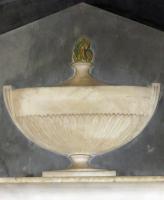
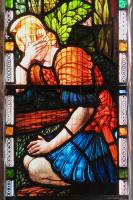
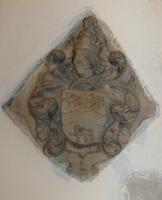
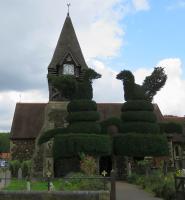
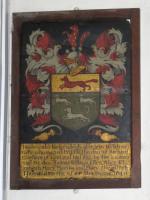
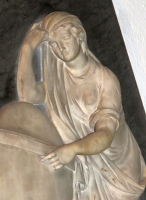
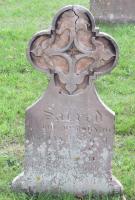
Bedfont, known for being the first place in England to host a ready mixed concrete plant,
or perhaps not so well known for this, is within Middlesex in the bleak vicinity of Heathrow, just to the south.
The Church, St Mary, though most commented upon for its two large yew trees cut to the shape of peacocks,
contains several modest panel monuments, including three 17th Century examples,
and one later piece with a sculpture of a mourning girl, by the sculptor Richard Blore.
Other plain tablets include pieces by the prolific Physick family of mason-sculptors,
one by Tomlinson of Uxbridge, and another by Samuel Cundy of Pimlico.
The Church
A few words on the Church itself. It is ancient, retaining some Norman features, and the nave and chancel
date from the 12th century, with an extension to the nave in the 13th Century.
But in 1829, a ‘huge transeptal excrecescence’ was added by taking out the northern side of the nave.
Later on there was a good Victorian restoration, which discovered 13th Century wall paintings (see end of page),
and saw the replacement of the previous spire with construction of the short tower with its charming wooden belfry
and spire; the clock, I believe, was added in Edwardian times as a memorial to Edward VII’s coronation.
From the outside, Bedfont Church is most attractive, on account of the short wooden spire with projecting clock.
The yew trees obscure the view from the entrance, so the best view of the Church itself is a three-quarters one,
showing the nave with its Gothic door and rose window above, and the short, stubby buttressed tower to advantage,
as well as that spire. From the other side, the extension is rather flat and the tower is too short to show well.
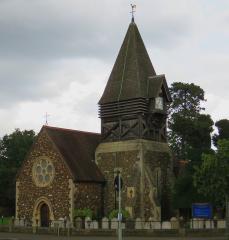
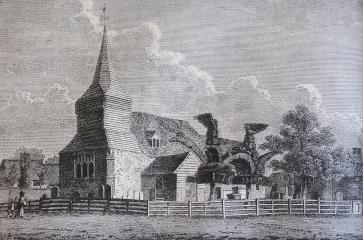
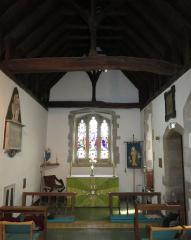
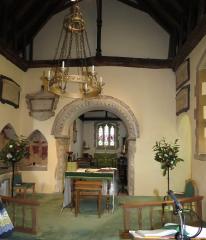
Bedfont Church, St Mary.
Inside the Church is of small size and atmospheric, much being owed to the dark wooden roof,
and the narrowness of the nave, which is separated from the Chancel by a small Norman chancel arch,
which essentially makes it a separate area - two pictures are below right. There is a single wing opposite the porch, the 1829 addition
which looks much better from the inside than outside, which is separated from the nave by two arches.
The monumental panels are mostly dotted around the walls of nave and chancel, also helping the ambience.
Monuments
- Mathew Page, d.1631, and his mother, Isabell Page, d.1629. A small brass.
Above the inscribed panel, now sat directly upon it, which likely would not have been the case originally,
are the brasses of the two persons commemorated, simply delineated but nicely done.
They are shown with hands raised in prayer, facing three quarters towards each other.
Mathew Page has curly hair, a pointed beard, and a fine moustache, and wears a long robe with tassels
at waist and sleeves. His mother, a somewhat grimmer figure, has a huge ruff and an elegant hat,
and the usual shapeless figure beloved of the early 17th Century.
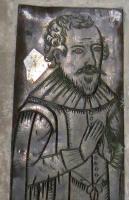
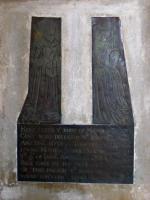
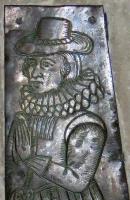 Brass to Mathew Page, d.1631, and Isabell Page, d.1629.
Brass to Mathew Page, d.1631, and Isabell Page, d.1629.
- Thomas Weldish, d.1640, noting his wife Priscilla, daughter of Richard Goreham of Kent,
and his eight named children, including two called Mary, suggesting the first one had died.
The inscription is surmounted by a painted coat of arms, and the whole is mounted in a modern wooden frame.
Interesting to find something quite like this. A picture is at the top of this page - you will need to click to enlarge to see properly.
- Francis Page, d.1678, a plain brass panel with an inscribed shield of arms above;
it is rather shiny, as it came from a ledger stone on the floor of the Chancel. It includes a little ditty,
‘A vertuous (sic) life & good old age// perfumed ye memory of Francis Page’. Erected by his son John Page,
Merchant of Virginia.
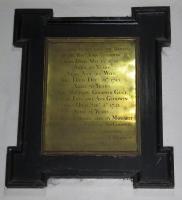 Revd. Goodwin, d.1752 and family. Brass and seemingly contemporary surround.
Revd. Goodwin, d.1752 and family. Brass and seemingly contemporary surround.
- Revd. John Goodwin, d.1752, his wife Ann Goodwin, d.1745, and their son,
Matthew Goodwin, d.1753. Erected by their daughter, Margaret Goodwin. A brass panel
with a thin inner frame and a thicker outer one, with the corners enlarged to squares, reminiscent of strapwork
of a century or two previously. Revd Goodwin was the vicar of Bedfont at the time when the yew trees
were cut with the peacocks, see bottom of this page.
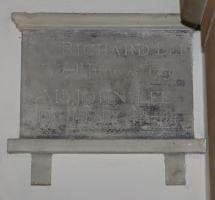
Lee monument, mid 18th Century.
- Richard Lee, d.1759, and John Lee, d.1764. A pale panel with upper and lower shelf,
supported on a pair of brackets. High up and hard to read, so I include a picture though there is nothing sculptural about the piece.
- Maria Whitfield, d.1795, wife of Henry Whitfield, d.1849, with a Latin inscription.
A nice example of a polychrome marble panel, a type which was popular in the 18th Century
and came to an abrupt stop when the Napoleonic wars broke out and stopped import of coloured marbles.
The inscribed panel to Maria Whitfield has a thick border of red-brown and white marble,
slanting outwards to the top; there are scrolly side-pieces, and above is a lid or pediment
bearing a painted shield of arms with crossed branches, with a coronet and deer’s head above.
At the base, small feet left and right, so the whole monument is styled as a casket end. But added later,
is an apron in between these feet, bearing the inscription to Henry Whitfield, over half a century after the earlier inscription.
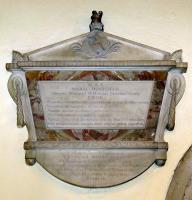
Maria Whitfield, d.1795, example with coloured marble.
- Mrs Jane Smith Barry, d.1806, and various members of the Williamson and Reed families,
through to William Reed, d.1865. Tall panel (see picture below left) with a low relief carved pot on top,
and a painted shield of arms surrounded by a pair of crossed branches below, with brackets
to the sides bearing stylised flowers, and a couple of lines curving below: ‘A sign the absent Claims the Dead
a Tear. // Forgive the wish, that would have kept thee here.’ On a shaped black backing, and signed by
Tomlinson of Uxbridge, a notable firm from somewhat north of the Church: there are various tablets by this firm
in West London and beyond.
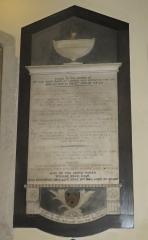
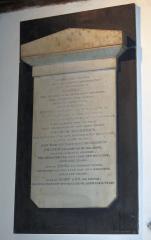 White on black panels, vertical format, by Tomlinson and Samuel Cundy.
White on black panels, vertical format, by Tomlinson and Samuel Cundy.
- William Sherborn, d.1807, his wife Ann Sherborn, d.1815, another
William Sherborn, d.1825, and a daughter, Elizabeth [Sherborn] Tillyer, d.1828, and
Edward Sherborn, d.1846. We might note en passant that the Sherborns were related to the Goodwins
by marriage. A fine obelisk memorial with a sculpture of a mourning girl. The inscribed panel has a shelf above,
on which rests the black obelisk, rather short, and the figure sculpture almost fills the available space.
To the left is a large funeral urn, thin stemmed and with a tall lid, thus almost egg-shaped.
Resting her elbow on the top of this is the stooping girl, the hand against her brow, her other arm forwards
in front of her body and stroking the body of the urn. She is dressed in Classical drapery,
insofar as she wears a great cloak which doubles as a long dress from the bottom of which one
unclad foot peeps out, but her shirt has a thin collar, not Classical, and her visible sleeve is rolled up –
definitely not Classical. The hanging forward of the drapery gives a dumpy look to the figure,
but nevertheless it is well made in its parts, especially the nearmost arm and hand,
with a beautiful line underneath, and the Classical head, with Greek nose and chin, and columnar neck.
The base of the monument is supported on two brackets with mouldings, between which is a curved apron
bearing a shield of arms, and one of these brackets is signed by the sculptor, R. Blore of London.
There were two sculptors with the name Robert Blore, senior and junior, significant monument makers of their time
- see this page for a little more information.
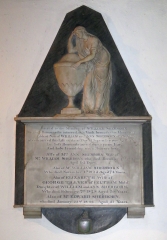
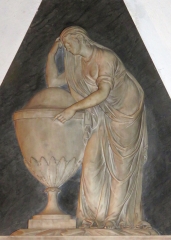 Robert Blore's sculpture for William Sherborn, d.1807.
Robert Blore's sculpture for William Sherborn, d.1807.
- Lieutenant Colonel George Engleheart, d.1833, of the
Honourable East India Company’s Bengal Establishment. Pale panel with a broad, dark border,
and two small supports.
- Captain James Bruere, d.1838, wife Mary Adams Bruere, d.1852,
their second daughter Caroline Molesworth Bruere, d.1849, and their seventh son,
James Tucker Bruere, d.1830 by drowning. The tablet was ‘erected to four of a numerous
and beloved family by Charlotte Neale Bruere, youngest daughter and only survivor, 1858.
Her monument is noted further down this page. Tall panel with line border, cut to a point at the top,
with a blocky base, on a shaped black backing. There is a painted coat of arms above the inscription.
Signed faintly by E. Physick, Regents Park Road. The Physick family of sculptor-stone masons was large;
some information on them is on this page.
- James Evans, d.1842, of the Bengal Medical Service. Blocky panel with small feet, a shelf above,
and on that a light relief of a pot with drapery to form a pediment shape. On a shaped black backing.
- Agnes Eliza Jones, d.1843, daughter of the Vicar, Robert Jones, whose monument is noted below.
A tomb chest end with upper shelf and lid, cut with feet, on a shaped black backing with two block supports,
one signed by the stonemason company The Patent Works, Esher Street, Westminster.
- Revd. Robert Jones, d.1844, Vicar of the Parish, who died in Jersey,
‘where he had gone for the benefit of his health’, with the implied reproof that he should not have gone.
Simple Classical piece, cut as a tomb chest end with a blocky pediment and little feet,
on a shaped black backing with two block supports. Similar to the monument of his daughter who had died
the year before, and again by the stonemason company The Patent Works, Esher Street, Westminster.
- Agnes Jones, d.1847, just a few years after her daughter and husband.
Again with an upper shelf and pediment or lid, and slightly cut feet, on a simpler shaped black backing.
- Martha Sherborn, d.1847, daughter Martha, d.1853, husband Francis Sherborn, d.1864,
son Francis, d.1892,and daughters Elma, d.1895 and Mary Ann, d.1897.
A panel with nipped bottom corners, and cut to a blocky pediment above, on a rectangular black backing.
Signed by the stonemason S. Cundy of Pimlico. Samuel Cundy, himself son of a stonemason,
seems to have worked more on church repairs than monumental tablets. See picture a little way up the page.
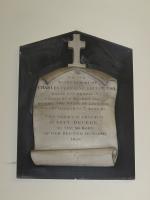
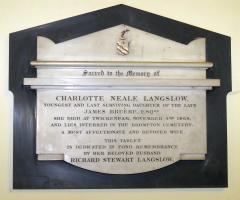 Physick family monuments: Major Bruere and Charlotte (Bruere) Langslow.
Physick family monuments: Major Bruere and Charlotte (Bruere) Langslow.
- Major Charles Fleeming Bruere, d.1857, of the 13th Bengal NI, ‘killed by a musket ball
during the siege of Lucknow’. One of the nicest types of white on black tablet (picture above left),
with the inscribed white marble carved as a scroll, curling over at the top on either side of a central pin,
and with the bottom rolled up. A nice thing, erected in 1858 by his wife, Lucy Bruere.
Signed by Physick, Marylebone Road but I could not read an initial. The earlier tablet to Bruere
was also by one of this numerous family of sculptor-masons.
- Charlotte Neale [Bruere] Langslow, d.1868, whom we met earlier when she put up the monument
to several members of her family. With two shelves across the central panel, which is cut with a pediment
and ‘ears’, with a painted shield of arms - see picture above right. On a shaped black backing, signed by E.J. Physick of London,
who is Edmund James Physick, one of the more gifted sculptors of the Physick family.
- Lieut. Colonel Reed, d.1874, and his wife Celina Adelaide [Cooper] Reed, d.1914.
An elaboration on the normal white on black monument: above and below the inscribed central panel are shelves
with carved, repeating patterns. On top of the upper shelf is a pot in high relief, quite exotic,
and below is a curved apron bearing the carved coat of arms, between two curly brackets.
On a shaped black backing, but unfortunately I could not see a signature of the stonemason or sculptor.
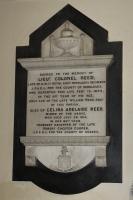
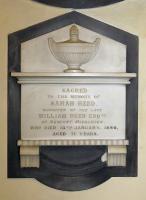
Later panels to the Reed offspring: Lt. Col. Reed, d.1874, Sarah Reed, d.1880.
- Sarah Reed, d.1880. A charming little monument; above the inscription is a shelf with moulding,
and on top of this is a perfect Classical urn curved in high relief. At the base, another shelf and two brackets,
all with simple fluting. On a shaped black backing with a curved base to balance the pot on top.
This is really late for a white on black panel, noticeable by the freer style of Victorian times.
- Lieut. Arthur W. Pike, d.1918, and LC. Corporal George F. Pike, d.1915,
killed in France and Belgium respectively. Pale panel with carving of a pair of guns, crossed, in a shallow oval.
An example of the more austere style of monument which was taking hold from this time - see picture below.
- James Alexander, d.1920, Parish Clerk, Sexton and Bellringer for 39 years.
An oval within a black rectangle, hearkening back to a style of over a century previously.
- John Wilson Coles, d.1928, erected by ex-Service Members of the Bedfont and Hatton Branch
of the British Legion: he had been founder and first president of the branch. Brass tablet with blackletter text,
and an inscribed line border. Having seen the old brasses, it is nice to see one of the revival ones,
which came in during Victorian times, and lasted well into the 20th Century – though this one is rather late.
- Pamela Galloway, d.1955, a small wooden panel.
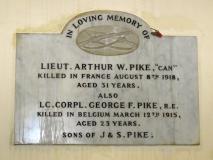
WW1 Pike monument, with crossed rifles.
Also in the Church
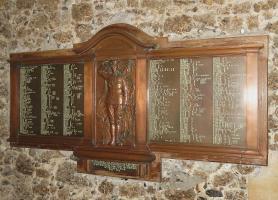
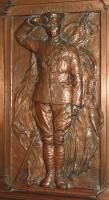
Myrander's World War 1 Memorial.
Outside the Church
Well, we have to mention those yew trees with the peacock topiary. The one bears the date 1704,
and the other used to have the initials JH, JG and RT – the vicar of that time
[John Goodwin, whose brass we noted above] and churchwardens [John Hatchet and Robert Tillyer].
Each tree was cut to the shape of a peacock at the top, in the ‘unnatural art of topiary’ –
Thomas Hood wrote a fanciful poem about these trees, supposing them to relate to two unmarried and haughty sisters;
it is readily findable online but has nothing helpfully descriptive of the Church or the monuments,
or in fact the peacocks. The topiary was renewed or revived in 1865, and again since, most recently in 1990,
which date is now on the second tree, replacing the initials.
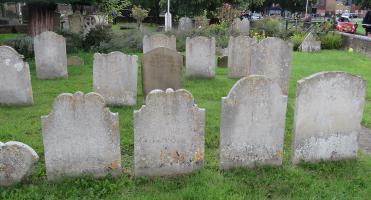
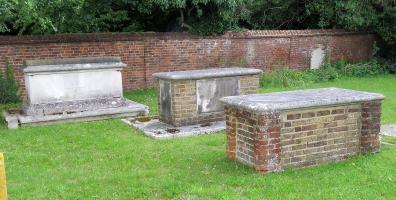
Bedfont St Mary Churchyard: headstones and tomb chests.
So far as the Churchyard monuments go, they consist of several chest tombs,
and a fair number of simple headstones, some of which have double heads, and a few with interesting variations
on types of crosses – much more on the variety of crosses in churchyards on this page.
Alas, I did not notice the chest tomb to ‘John Stanley, King of the Gypsies’,
erected at the cost of his subjects, which bore the familiar inscription
‘Readers all as you pass by // As you are now so once was I // As I now am so you must be //
Prepare for death and follow me.’
With many thanks to the Revd Philip Smith for permission to show pictures of the monuments inside the Church; St Mary's website is
at http://www.stmarysbedfont.org.uk/.
Top of page
Just north of Heathrow: Harmondsworth Church // and Harlington Church // Some other London Churches
Introduction to church monuments // London sculpture // Sculptors
Home
Visits to this page from 25 Aug 2017: 7,680







 Revd. Goodwin, d.1752 and family. Brass and seemingly contemporary surround.
Revd. Goodwin, d.1752 and family. Brass and seemingly contemporary surround.

 White on black panels, vertical format, by Tomlinson and Samuel Cundy.
White on black panels, vertical format, by Tomlinson and Samuel Cundy.

 Physick family monuments: Major Bruere and Charlotte (Bruere) Langslow.
Physick family monuments: Major Bruere and Charlotte (Bruere) Langslow.






